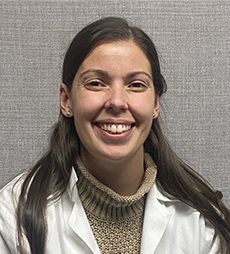Eosinophilic Esophagitis (EoE)
You are here:
Eosinophilic Esophagitis (EoE)
Eosinophilic (ee-uh-sin-uh-fil-ik) esophagitis (EoE) is a recently recognized allergic/immune condition. A person with EoE will have inflammation or swelling of the esophagus. The esophagus is the tube that sends food from the mouth to the stomach.
In EoE, large numbers of white blood cells called eosinophils are found in the tissue of the esophagus. Normally there are no eosinophils in the esophagus. EoE can occur at any age and most commonly occurs in Caucasian males. The symptoms of EoE vary with age. In infants and toddlers, you may notice that they refuse their food or are not growing properly. School-age children often have recurring abdominal pain, trouble swallowing or vomiting. Teenagers and adults most often have difficulty swallowing. The esophagus can narrow to the point that food gets stuck. This is called food impaction and is a medical emergency.
Allergists and gastroenterologists are seeing many more patients with EoE. This is due to an increase in the frequency of EoE and greater physician awareness. EoE is considered to be a chronic condition.
Other diseases can also result in eosinophils in the esophagus. One example is acid reflux.
Diagnosing Eosinophilic Esophagitis
Currently, the only way to diagnose EoE is with an endoscopy and biopsy of the esophagus. An endoscopy is a medical procedure that lets your doctor see what is happening in your esophagus. During a biopsy, tissue samples will be taken and analyzed.
The EoE diagnosis is made by both a gastroenterologist and pathologist. There are certain criteria for diagnosing EoE that are followed by gastroenterologists, pathologists, and allergists. These include a history consistent with EoE, a visual look at the esophagus during the endoscopy procedure, and careful evaluation of tissues taken from the esophagus by a pathologist.
Environmental allergies to substances such as dust mites, animals, pollen, and molds can play a role in EoE. For some patients, it may seem like their EoE is worse during pollen seasons. Allergy testing for these common environmental allergies is often part of the EoE evaluation.
Adverse immune responses to food are the main cause of EoE in a large number of patients.
Allergists are experts in evaluating and treating EoE related to food allergies. However, the relationship between food allergy and EoE is complex. In many types of food allergy, the triggers are easily diagnosed by a history of a severe allergic reaction like hives after ingestion of the food. In EoE, it is more difficult to establish the role of foods since the reactions are slower, and so a single food is hard to pinpoint as the trigger. Allergists may do a series of different allergy tests to identify the foods causing EoE. Foods such as dairy products, egg, soy, and wheat are main causes of EoE. However, allergies to these foods often cannot be easily proven by conventional allergy tests (skin tests, patch tests, or blood tests). Once a food has been removed from a person’s diet, symptoms generally improve in a few weeks.
People who have allergies react to a particular substance in the environment or their diet. Any substance that can trigger an allergic reaction is called an allergen.
Prick skin testing introduces a small amount of allergen into the skin by making a small puncture with a prick device that has a drop of allergen. Foods used in allergy testing sometimes come from commercial companies. Occasionally, foods for skin prick testing are prepared fresh in the allergist’s office or supplied by the family.
Allergy skin testing provides the allergist with specific information on what you are and are not allergic to. Patients with allergies have an allergic antibody called Immunoglobulin E (IgE). Patients with IgE for the particular allergen put in their skin will have an area of swelling and redness where the skin prick test was done. It takes about 15 minutes for you to see what happens from the test.
Sometimes an allergist may do a blood test (called a serum specific immune assay) to see if you have allergies. This test can be helpful in certain conditions linked to food allergies. The results of blood tests are not considered as helpful as skin prick testing in EoE and are not recommended for the routine evaluation of food allergy in EoE.
Eliminating foods based on prick skin testing alone does not always control EoE. Food patch testing is another type of allergy test that can be useful in diagnosing EoE. This test is used to determine if the patient has delayed reactions to a food. The patch test is done by placing a small amount of a fresh food in a small aluminum chamber called a Finn chamber. The Finn chamber is then taped on the person’s back. The food in the chamber stays in contact with the skin for 48 hours. It is then removed, and the allergist reads the results at 72 hours. Areas of skin that came in contact with the food and have become inflamed point to a positive delayed reaction to the food. The results from the food patch test will help your doctor see if there are foods you should avoid.
Working with Your Doctors
EoE is a complex disorder. It’s important for patients to listen to their gastroenterologist for advice on
managing EoE and figuring out when endoscopies are needed to check to see if the condition is getting
better or worse. Patients also need to work closely with an allergist/immunologist to find out if allergies
are playing a role. An allergist/immunologist will also be able to tell if you need to avoid any foods and
can help you manage related problems like asthma and allergic rhinitis. If you are following a diet to
treat your EoE, it’s often recommended to visit a dietitian.





